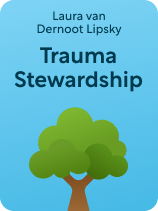

This article is an excerpt from the Shortform book guide to "Trauma Stewardship" by Laura van Dernoot Lipsky. Shortform has the world's best summaries and analyses of books you should be reading.
Like this article? Sign up for a free trial here.
How do you focus on the positives when you’re constantly exposed to negativity? How can a positive outlook on life help you cope with trauma?
It may feel hard to get rid of negative thoughts when you’ve been exposed to secondary trauma as a caretaker. With the help of Trauma Stewardship by Laura van Dernoot Lipsky, you can shift your focus to the positive things in life, even if they’re small.
Find out how to focus on the positive and get rid of the negativity that’s dampening your mood.
Think About the Positives
When exposed to trauma, you might feel overwhelmed by how bad situations seem and how little control you have over them. However, Lipsky argues that you can restore your sense of agency by deliberately knowing how to focus on the positives rather than negatives—on what you can do instead of what you can’t. This practice reminds you that you have a choice in every moment and allows you to reframe situations in healthier ways and take productive action. When you regularly choose to focus on positive things, it becomes easier to notice the positives. Lipsky cautions, though, that reframing situations to see their upsides doesn’t mean suppressing your negative emotions.
(Shortform note: In The Happiness Advantage, Shawn Achor writes that learning to see the positives during challenging moments allows you to grow and become more resilient. Seeing the positives doesn’t mean ignoring problems or your feelings; rather, you’re choosing to notice the good that’s there alongside the problems. To do this, Achor recommends making a short list of what makes you happy or grateful every day or writing about a positive experience.)
To take control of your focus, Lipsky offers a few suggestions:
Focus on your resources. When you feel overwhelmed or distressed, think about the sources of support and comfort you have in your life—the memories you’ve had, the people you know, or the places you’ve visited that you associate with peace and calm. For example, you might imagine your favorite reading nook or your pet. When you direct your awareness to your resources, you draw your attention away from what’s distressing you. This allows you to snap yourself out of your panic and calm your nervous system.
(Shortform note: While Lipsky advises you to think about the resources you have in your life, you can also think about anything that makes you happy—what Rhonda Byrne calls “thought lifters.” In The Secret, Byrne adds a layer of specificity to Lipsky’s suggestions on how to redirect your focus in stressful moments: First, make a list of thought lifters, such as cute animals or a beautiful sunset. When you’re feeling negative emotions, close your eyes and smile for at least a minute. Then, concentrate on a thought lifter and how it makes you feel, and move down the list until you’re feeling better.)
Make a Plan B. Create an alternative vision of your life, whether it involves a shift in your career, a move to a different location, or an entirely new lifestyle. When you consider alternative options, you recognize that you have a life outside of your work and that you always have the freedom to choose how you want to live it.
(Shortform note: In Designing Your Life, Bill Burnett and Dave Evans suggest you plan out three different lives to remind yourself that there are multiple paths to happiness and fulfillment. Your first plan should be the life you’re currently living. Your second plan should be what you would do if your current line of work disappeared. Your third plan should be what you’d do if money or the opinions of others didn’t matter. To create each plan, write a short title and a timeline containing the experiences and activities you’d like to enjoy. By having multiple plans, you might better recover a sense of control over your life.)

———End of Preview———
Like what you just read? Read the rest of the world's best book summary and analysis of Laura van Dernoot Lipsky's "Trauma Stewardship" at Shortform.
Here's what you'll find in our full Trauma Stewardship summary:
- That the best way to care for others is to care for yourself
- How trauma damages the caregivers who are exposed to others' trauma
- How caregivers can manage secondary trauma to better support others






